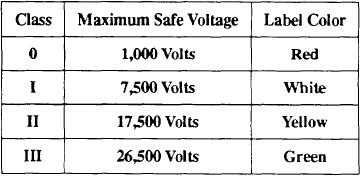
RUBBER GLOVES
DECK MATTING
There are four classes of rubber insulating gloves.
An insulating deck covering prevents electric shock
The primary feature being the wall thickness of the
to anyone who may touch bare, energized, ungrounded
gloves and their maximum safe voltage, which is
circuits. You must use approved rubber floor matting in
identified by a color label on the glove sleeve. Use only
electrical and electronic spaces to eliminate accidents
rubber insulating gloves marked with a color label.
and afford maximum protection from electric shock.
Table 1-1 contains the maximum safe use voltage and
NSTM, chapter 634, table 634-1, gives approved deck
label colors for insulating gloves approved for Navy use.
coverings for every space in your ship. Accident
Before using rubber gloves, carefully inspect them
investigations often show that the floors around
for damage or deterioration. To inspect robber gloves
electrical and electronic equipment had been covered
for tears, snags, punctures, or leaks that are not obvious,
only with general-purpose black rubber matting. The
hold the glove downward, grasp the glove cuff, and flip
electrical characteristics of this type of matting do not
the glove upward to trap air inside the glove. Roll or
provide adequate insulation to protect against electric
fold the cuff to seal the trapped air inside. Then squeeze
the inflated glove and inspect it for damage. For
shock. There are various types of electrical grade mats
additional information on rubber gloves, refer to Naval
or sheet coverings conforming to Military Specification
Ships' Technical Manual, chapter 300.
Mil-M-15562 that meet the requirements.
To ensure that the matting is completely safe, you
ELECTRICAL FIRES
must promptly remove from the matting surfaces all
When at sea, fire aboard a Navy vessel is more fatal
foreign substances that could contaminate or impair its
and damaging to both personnel and the ship itself than
dielectric properties.
damage from battle. The time to learn this is as soon as
Th dielectric properties of matting can be impaired
you report aboard. The Navy requires that all hands must
be damage control qualified within 6 months after
or destroyed by oil, imbedded metal chips, cracks, holes,
reporting aboard. You must learn the types of
or other defects. If the matting is defective, cover the
fire-fighting equipment, their location, and their
affected area with a new piece of matting. Cementing
operating procedures. It is too late after the fire has
the matting to the deck is not required, but is strongly
started.
recommended This prevents removal of the mat for
inspection and cleaning, which would leave the area
FIGHTING AN ELECTRICAL FIRE
unprotected. If the mat is not cemented, stencil an
outline of the proposed mat on the deck. Inside the mat
Use the following general procedures for fighting
outline, stencil " E L E C T R I C - G R A D E M A T
an electrical fire:
REQUIRED WITHIN MARKED LINES." Use
1. Promptly de-energize the circuit or equipment
3/4-inch or larger letters.
affected. Shift the operation to a standby circuit
or equipment, if possible.
Electrical insulating deck covering should be
installed so there are no seams within 3 feet of an
2. Sound an alarm according to station regulations
electrical hazard. Where this is not possible,
or the ship's fire bill. When ashore, inform the
thermoplastic deck coverings, such as vinyl sheet
Table 1-1.--Rubber Gloves
manufactured by Lonseal, Inc., should be fused
chemically, heat welded, or heat fused with a special hot
air gun. With rubber deck coverings, fusing with heat
is not possible. A 3- or 4-inch wide strip of #51
Scotchrap 20-mil thick Polyvinyl Chloride (PVC) tape
(manufactured by Minnesota Mining and
Manufacturing Company) should be installed beneath
the seam. You also may use a 1-foot wide strip of
electrical grade deck covering under either rubber- or
vinyl-type coverings (instead of heat welding vinyl).
1-16

